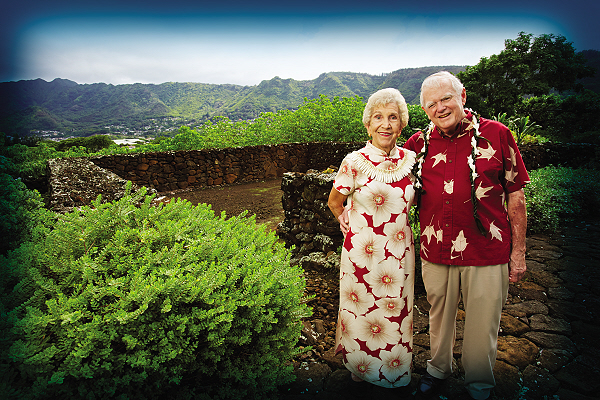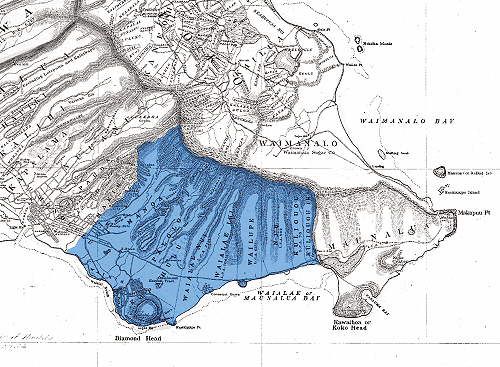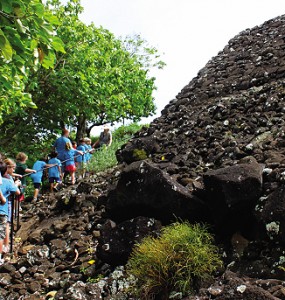
Sam and Mary Cooke stand at the entrance of Kuka‘o‘o heiau. And just above, in the background ridge, is the silhouette of Kauhi, the sleeping giant.
Manoa Heritage Center in Manoa Valley is a non-profit organization founded by Sam and Mary Cooke to preserve and share with our community an ancient Hawaiian worshipping site that is located on their property. We were invited to visit the center and meet these gracious people who have devoted much of their lives to preserving a Hawaiian historical landmark.
The Hawaiian Dictionary defines heiau as “pre-Christian place of worship, shrine.” Nothing spooky about it — Hawaiian families had personal shrines, and high chiefs built communal shrines to meet guests, say farewell to the departed, heal disputes and observe special monthly and seasonal rites connected to farming and fishing. All life was connected to sky, land and sea. Of fourteen heiau in the Ahupua‘a of Waikiki, only one agricultural temple remains intact — Kuka‘o‘o Heiau in Manoa Valley.
The Ahupua‘a of Waikiki is a triangular land division that starts at the Ko‘olau Mountain Range and extends to the sea. Its boundaries embrace Makiki, Manoa and Palolo Valleys and the fishing grounds beyond Waikiki beach. This land sustained ancient O‘ahu kings and chiefs of the past.
We drove a short distance up Manoa Road from Punahou School, to Manoa Heritage Center (MHC) to visit Kuka‘o‘o Heiau and meet MHC founders, Sam and Mary Cooke. They are the third generation of Cookes to steward this site, and are busy raising funds to construct a modest new Visitor Education Center. The center will allow for a wider variety of educational activities, meeting rooms, and more visitor amenities for students and the community.
A Place-Based Learning Journey in Manoa
Connecting story to place is what teachers call “place-based education.” It turns a visit to MHC into not only a historical, cultural experience, but also a spiritual encounter with the skies, winds, rains and landmarks of Manoa Valley.
 Manoa Heritage Center sits on the western slopes of Manoa where the old ali‘i resided. We looked out across the eastern half of the valley, where taro farmers once maintained an expanse of taro patches. We located legendary landmarks, such as Kauhi the sleeping giant (shown on the opening spread) and watched dazzling Manoa rainbows dance on the famous Tuahine mist.
Manoa Heritage Center sits on the western slopes of Manoa where the old ali‘i resided. We looked out across the eastern half of the valley, where taro farmers once maintained an expanse of taro patches. We located legendary landmarks, such as Kauhi the sleeping giant (shown on the opening spread) and watched dazzling Manoa rainbows dance on the famous Tuahine mist.
MHC Education Director Margo Vitarelli guided us through the gardens and explained how Hawaiians ingeniously used the endemic, indigenous and Polynesian canoe plants growing all around us. Some, like the endangered Monroidendron tree from Kaua‘i, are rare species not often seen on the island of O‘ahu. Other native varieties are elegantly landscaped in large beds to reveal their beautiful textures and foliage colors: ‘akia, shrubs with bright orange berries and tough, gray-green round leaves stacked like pennies; rubbery, light green naupaka hedges; and proud koki‘o ke‘oke‘o bushes covered with fragrant white hibiscus. These plants and many others were used to catch fish and make rope, tools and weapons and compound medicines — to sustain life in the ahupua‘a. “Learning plants by their use is meaningful to kids,” said Vitarelli.
The Only Intact Heiau in Waikiki Ahupua‘a
Margo explained that the Hawaiian name, Kuka‘o‘o, actually means “standing digging stick” or “god of the digging stick.” The ‘o‘o is an indispensible digging and planting tool still used by farmers today. Archaeologists estimate that Kuka‘o‘o is 800 years old, based on carbon dating and oral history. It is interpreted as a mapele agricultural temple, to celebrate and benefit growth, harvest and a harmonious life.
Flanking the stone path leading to Kuka‘o‘o is a section of the dry-stack wall said to be built by the ancient people and expert stone masons — the Menehune. Walls like this once meandered across Manoa Valley. At the lower heiau path we looked up to see the neatly constructed stones sloping upward, rising over our heads about 15 feet. Different layers of masonry styles observed during restoration and legends associated with Kuka‘o‘o suggest that perhaps this ancient heiau was rebuilt several times in antiquity, most likely when power shifted from one chief to another. After walking up to the top of the site, we beheld the entrance to a beautifully restored heiau. The backdrop of the Ko‘olau Mountains and majestic aura of the huge sky was breathtaking.

Caring People Doing the Right Thing
After touring this fabulous site, we were eager to meet the people who generously opened their gardens to the community. Back at the center, Sam and Mary Cooke greeted us warmly. As we sat on the porch and enjoyed glasses of red hibiscus tea, I asked them how they came to restore Kuka‘o‘o. As a fine cooling mist blew in from the valley, Mary reminisced, “I can only say that we restored this place out of our love for the Hawaiian culture. I have always been involved in protecting heritage places.” Mary grew up on Kaua‘I with a deep reverence for Hawaiian ways and their history. Sam descends from Wilcox missionaries who serviced Waioli Mission and later built Grove Farm in Lihue. For nine years Mary served on the board of the National Trust for Historic Preservation, advocating the registry of many important Hawai‘i sites.
Sam’s ancestors were collectors and preservationists. Sam’s great-grandmother, Anna Rice Cooke, provided land, capital and art to begin what is now known as the Honolulu Museum of Art. His great grandfather Charles Montague Cooke Sr., provided land for the University of Hawai‘i, started Bank of Hawai‘i and funded The Honolulu Aquarium. Sam’s grandfather, Dr. Charles Montague Cooke Jr., was a distinguished scientist (malacologist) at the Bishop Museum for over 40 years, and at one time bred dairy cattle at his Ka ‘Imi Dairy in Manoa Valley.
Despite this rich legacy, Sam described his own motivation to restore Kuka‘o‘o very simply: “It was the right thing to do.” Sam grew up on Moloka‘i and O‘ahu, where accepting kuleana (responsibilities) with gratitude, and doing what’s pono (righteous) goes without saying. He admits that restoring a cultural site without public funding turned out to be a very complicated and expensive proposition. “It cost so much that we had to take it in steps. First we did archaeological studies. Then we hired an expert Hawaiian stone mason, Billy Fields, from Hawai‘i Island — he’s the best — to restore the walls of the heiau that had deteriorated over the years. Cultural expert Nathan Napoka, then with Hawaii State Department of Land and Natural Resources (DLNR) Historic Preservation Division, coordinated the process with the proper Hawaiian protocol.”
The heiau stands directly behind Kuali‘i, the home Charles Montague “Monty” Cooke Jr., Built in 1911, on land given him by his father, Charles Montague Cooke Sr.. Sam and Mary purchased it 1970, restored it to its original English Tudor style splendor and listed it on the National Register of Historic Places. It is named after a famous O‘ahu king credited in oral history with driving the Menehune from Manoa Valley and Kuka‘o‘o. At one point, the heiau land was passed on to another Cooke relative. In 1993, when Sam and Mary heard that the heiau parcel was for sale, they intervened and bought it to save the heiau from destruction. The rest is redemption.
“Having a restored heiau in your backyard does draw some attention,” said Sam, referring to the many historians, Hawaiians, students and visitors who came to inquire. “We saw a need to open it to the public, so we started the Manoa Heritage Center 501(c)(3) in 1996,” said Mary, who has considerable experience as a board member of National Trust for Historic Preservation, “I observed that heritage sites with no endowment do not make it, financially. So one of our goals is to raise funds for an endowment.” Donations from the public have helped MHC commission Historian and Playwright, Victoria Kneubuhl, to conduct research and create an Interpretive Plan. This comprehensive document guides MHC as it presents the history and culture of this hisoric site and Manoa Valley to students and visitor tours in an educational and entertaining way.
Education Director, Margo Vitarelli, Pacific Island specialist, museum educator and artist coordinates center activities. She designs tours and activities for visiting schools and adults, produces a bi-annual newsletter, and conducts training classes for docent guides. Aloha McGuffie donates her expert talents in event organizing, report writing, scheduling and data collection. The Center welcomes over 2,000 visitors a year. Thanks to one thoughtful donor, MHC is able to offer a generous bus subsidy to schools that need transportation to the site. This allows all students the opportunity to visit for free.
What Hawaiians Taught the Missionaries
Sam’s ancestors, Amos and Juliet Montague Cooke educated the children of Hawaiian high chiefs at the Royal School. They and their children learned Hawaiian culture and values from their students. Hawai‘i became their home.
A kahuna la‘au lapa‘au (traditional healer) called Ka‘aha‘aina Naihe from Hawai‘i Island saved the life of Amos’ grandson, Charles “Monty” Montague Cooke Jr., who was born prematurely. Ka‘aha‘aina brought her Hawaiian medicinal knowledge to Manoa. Her lasting influence in Monty’s life may have been the reason he protected and saved the heiau site.
Manoa Heritage Center In The Future

As stewards, Sam and Mary make decisions for future generations. The “right thing to do” now is to continue preservation, expand the gardens and increase learning opportunities for youth. Architectural plans show a modest Visitor Education Center that will allow for expanded of educational activities, exhibits and basic facilities with visitor comforts in mind. Included are expanded gardens, places for hands-on cultural activities and restroom facilities. A new driveway and parking lot will include a turnaround for school buses.
Sam and Mary are donating their home, Kuali‘i, so that it will eventually become a valued addition to MHC— open to the community, along with displays of historical Hawaiian art dating from western contact through the 20th century.
As we said good-bye to Sam and Mary, we understood the huge amount of time, energy and resources they personally have devoted to Manoa Heritage Center. I asked Mary if the work seems burdensome. “A burden? No, we never feel that way. The challenges keep us busy and on the go — we love it.” Her smile conveyed the joy with which the Cookes carry out their kuleana. Anyone who visits Manoa Heritage Center will feel this joy. It is a truly remarkable place and treasured gift to the community.
Sam and Mary invite you to bring your family to see Kuka‘o‘o Heiau and the native Hawaiian gardens Monday through Friday from 8:30 am to 3 pm. By advance appointment, visitors and school children may arrange intimate small-group guided tours by calling the office, 808-988-1287. Trained volunteer docent guides lead the tours. To keep this wonderful enterprise thriving, it is important that the communities not only enjoy it but also support it — so that MHC and its mission continue to inspire generations to come.
Donations to Manoa Heritage Center may be made at www.Manoaheritagecenter.org or by contacting Manoa Heritage Center: 808-988-1287 or manoaheritagecenter@hawaiianlet.net.



Leave a Reply